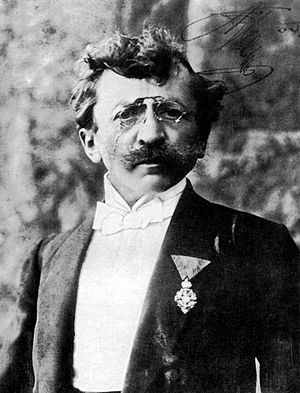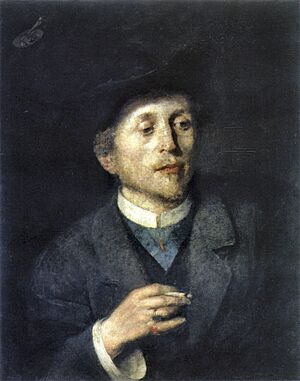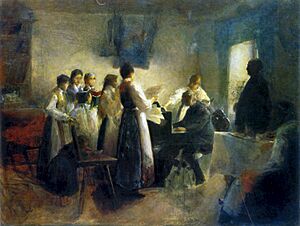Anton Ažbe facts for kids
Anton Ažbe (born May 30, 1862 – died August 5 or 6, 1905) was a Slovene painter and a well-known art teacher. He taught in a realistic style.
Anton Ažbe faced challenges from birth. He was physically disabled and became an orphan at age 8. Despite this, he learned painting by working with Janez Wolf and studying at art schools in Vienna and Munich.
When he was 30, Ažbe opened his own painting school in Munich. This school became very popular, especially for students from Eastern Europe. He taught many important artists. These included the "big four" Slovenian impressionists: Rihard Jakopič, Ivan Grohar, Matej Sternen, and Matija Jama. He also taught a whole generation of Russian painters like Wassily Kandinsky and Igor Grabar. Many Serbian painters, such as Nadežda Petrović, also studied with him.
Ažbe's teaching methods were so good that other artists adopted them. For example, Beta and Rista Vukanović used his methods when they took over another art school. Russian artists also used his ideas in their own countries and when they moved abroad.
Ažbe's own artwork is not very large. We know of only twenty-six of his drawings and paintings. Most of these are studies he made in class. They are kept at the National Gallery of Slovenia. He planned to create many great artworks, but they were never finished. Some people say he "never truly became a great artist" himself.
Ažbe was a bit of a mystery. He lived a very simple, private life but acted in an unusual way in public. He kept his personal life a secret, even from his students and friends. When he died young from cancer, people created many stories about his death. These stories became a kind of urban legend.
Contents
Anton Ažbe's Early Life
Anton Ažbe and his twin brother, Alois, were born into a farming family. This was in the village of Dolenčice near Škofja Loka. At that time, it was part of the Austrian Empire, but today it is in Slovenia.
Their father died when the boys were seven years old. Their mother became very distressed, so the boys were placed in foster care. It was clear that Anton had serious health problems from birth. He grew slowly, his legs were weak, and his spine was not straight. His legal guardian decided Anton could not do farm work. After elementary school, he sent Anton to learn about business in Klagenfurt.
Anton lived and worked in a grocery store for five years. Then, he ran away from Klagenfurt and went to Ljubljana. In the late 1870s, he met Janez Wolf, a Slovenian painter. Wolf was known for painting church murals. We don't know much about Ažbe's time with Wolf. But we do know that Ažbe helped Wolf paint frescoes in a church in 1880. He also helped with the outside of the Franciscan Church of the Annunciation in Ljubljana in 1882.
In the same year, Wolf helped Ažbe get into the Academy of Fine Arts in Vienna. Anton studied there for two years. He did not like the old-fashioned teaching in Vienna. He barely passed his classes. In 1884, he moved to the Academy of Fine Arts in Munich. This school was seen as more "modern" and "liberal." There, he greatly impressed his teachers. He even earned a free scholarship.
To earn money, Ažbe worked with Ferdo Vesel. They sold their classroom paintings and simple art to dealers. About half of Ažbe's surviving artworks are from his time at the Munich Academy. By the end of this period, he was known as a professional portrait painter. His work was regularly shown in the Glaspalast art exhibition.
Starting His Own School
In 1892, Ferdo Vesel and Rihard Jakopič asked Ažbe to help their students. A small group of seven students rented a room. They paid Ažbe to look at their paintings and help them improve. Just two months later, more students wanted his help. This allowed Ažbe to rent his own place and start the Ažbe School.
After a short time, the school moved to its permanent home at 16, Georgenstrasse in Schwabing. This building was later destroyed during a war in 1944. Ažbe later rented another building for classes. He moved his private art studio to a different spot on Georgenstrasse.
The school always had many students, usually around 80 at a time. About 150 students in total studied with Ažbe. Some, like Alexej von Jawlensky and Marianne von Werefkin, stayed for almost ten years. Ažbe was the only teacher for most of the time. For a short period in 1899–1900, he hired Igor Grabar as an assistant. Even big art schools like the Munich Academy and the Imperial Academy of Arts in Saint Petersburg recognized Ažbe's school. They often recommended it for students to prepare or improve their skills.
In 1904, Ažbe, who smoked for a long time, developed throat cancer. By the spring of 1905, he could barely eat. He agreed to have surgery. The surgery went well at first, but Anton Ažbe died on August 5 or 6, 1905.
After his death, people turned his sad but expected passing into a dramatic story. For example, Leonhard Frank, who studied with Ažbe, wrote a story about him. In it, he said: "Nobody ever saw his paintings. Nobody knew if he ever painted at all. Nobody knew his past." This shows how mysterious Ažbe was to many. The Ažbe school continued to operate even after its founder's death, until World War I began.
Anton Ažbe's Personality
We learn about Ažbe's personality from what his former students said about him. These stories can sometimes be different or even disagree. Ažbe never wrote books or articles about his teaching methods. His personal letters were destroyed. His other papers were only about business. We only have three postcards and one letter written by Ažbe himself.
It is not known if Ažbe ever had a family life. He once mentioned being engaged twice, but both times the marriages did not happen. He seemed to have a special connection with Kathi Kobus, who owned a local pub. But they both kept their relationship a secret until they died. Some students said he had a mysterious personality that made him look messy. Others, like Kandinsky, thought his ordinary life was a mystery in itself.
Ažbe was not a dwarf, but he was very short and had an unusual body shape. One description says he had very short, weak legs and a twisted upper spine. His head was large, but his face was narrow. Another artist, Igor Grabar, noted that Ažbe's wide forehead had many red veins. The rest of his face was red, as if he had a fever. At 33, he looked at least 40 years old. He styled his long brown mustache like Emperor Wilhelm II. He always wore expensive black clothes. In winter, he wore a tall, oriental karakul hat.
Because of his unusual appearance and expensive clothes, Ažbe became a target for newspapers and cartoonists. Boys on the street would tease him, shouting "Atzpe!" (a German mispronunciation of his name). Ažbe's own German was not perfect either. He often used the word nähmlich ("namely"). So, students sometimes called him "Professor Nähmlich." He usually spoke German in Munich, but he used Slovenian language when he was with other Slavic people.
Ažbe never had a proper home. He often slept on a messy sofa in his workshop, surrounded by his students' paintings. He always painted inside his studio and never painted outdoors. He often talked about his future great artworks, but none of them went beyond the sketch stage. He left Munich only once, visiting Venice in 1897. Otherwise, his life was spent between his school and local pubs. The pub owners often let a sleeping Ažbe stay on their premises. As he got older, he became less active. He replaced his daily walks with rides on a tram.
Ažbe stayed in touch with his brother Alois for a while but eventually stopped all contact. Ažbe was very generous. He never hesitated to offer free lessons to students who needed help. He also lent them money. An obituary, a notice of his death, said that "he was a man of almost legendary modesty... one of the most original and best-known people in Munich."
Anton Ažbe as an Artist
Some of Ažbe's loyal students, like Igor Grabar, said that his portraits had "superb drawing." However, they also noted that his painting technique was dry or even dull. Today, art critics have different opinions about Ažbe's importance as a painter. This is partly because we only have twenty-six of his confirmed artworks. Eleven of these are early paintings and studies from his student years. Only four paintings, made between 1890 and 1903, are considered his mature art. These were influenced by the Munich Secession, a group of artists. The largest of these, The Village Choir, was badly damaged during a restoration. We know from old photos and memories that he made other works, but they are now lost or in private collections.
Because there isn't much clear evidence, historians and critics have disagreed about Ažbe's art. Some art experts have studied Ažbe's connections with new art styles like avantgarde art and impressionism. They thought Ažbe was a pioneer of modern art, a link between artists like Cézanne and Kandinsky. However, other experts disagreed. They argued that Ažbe never mastered Cézanne's techniques and there's no proof he even tried.
Anton Ažbe as a Teacher
Artists who supported Ažbe's teaching and those who didn't, like Mstislav Dobuzhinsky, agreed on two main ideas he taught beginners. These were the Main Line and the Ball Principle (called Kugelprinzip in German).
Ažbe told beginners not to focus on small details. Instead, he made them build their image around one strong "Main Line." He made them draw with black charcoal. This allowed him to quickly and easily correct their work. Dobuzhinsky admitted that these changes to his early drawings were very helpful. He called it "an excellent tool against amateur, short-sighted copying of reality." However, for some students, it was too much. They felt overwhelmed by the "Main Line" and couldn't add enough details to their work.
The Ball Principle was often used for portraits. It taught that a human head is like a simple sphere or ball. So, lighting a human head follows the same rules as lighting a plaster ball. In this system, facial features are just bumps and hollows on the ball's surface. Once students understood these basics, Ažbe would teach them a different idea. He would show them how a head could be seen as a polyhedron. This is a shape made of flat surfaces and sharp edges. Dobuzhinsky thought this idea was an early step towards cubism, a later art style.
Ažbe was an expert in human anatomy, the study of the body. He made his students train very hard in this subject. Igor Grabar, who liked this approach, remembered learning all human muscles and bones by heart. He could even draw them with his eyes closed. Wassily Kandinsky, however, did not enjoy these drawing sessions of human figures.
Later in his life, Kandinsky mostly avoided painting portraits. His few portraits were "featureless, weightless, and transparent." They were very different from Ažbe's own goals. Yet, Kandinsky still valued Ažbe's belief that no theory or rules should limit an artist's creativity.
Painting with color was a goal for later stages of learning. Students first needed to master lines, shapes, and anatomy. Many students remembered that Ažbe disliked mixing paints on a palette. Instead, he suggested painting with pure, unmixed colors and wide brushes. Ažbe believed that a wide brush, loaded with layers of different paints, could paint a human forehead in one strong stroke. This skill took years of hard training. Ažbe often compared a good oil painting to a diamond. He said that pure paints must keep their own look, like the different sides of a gem. Ažbe himself started using this style, later called "crystallization of colour," in the mid-1890s. Igor Grabar praised this style, seeing it as a whole system similar to impressionism. But Dobuzhinsky, who never mastered the "power stroke," called it "a clever magic trick... colorful but greasy painting without its true essence."
Notable Students
Here are some of the famous artists who studied with Anton Ažbe, listed by when they joined his school:
- Rihard Jakopič (1892–)
- Ludvík Kuba (1895–1904)
- Ivan Grohar (1896–)
- Igor Grabar (1896–1901)
- Alexej von Jawlensky (1896–1905)
- Dmitry Kardovsky (1896–1900)
- Marianne von Werefkin (1896–1905)
- Matija Jama (1897–)
- Wassily Kandinsky (1897–1899)
- Yelena Makovskaya (1897–1899)
- Pavel Shmarov (1897–1898)
- Matej Sternen (1897–1905)
- Nadežda Petrović (1898–1901)
- Beta Vukanović (1872-1972)
- Ljubomir Ivanović (1882-1945)
- Borivoje Stevanović (1878-1976)
- Kosta Miličević (1877-1920)
- Milan Milovanović (1876-1946)
- Ivan Bilibin (1899)
- Olga Della-Vos-Kardovskaya (1899–1900)
- Mikhail Shemyakin (1900–1902)
- Mstislav Dobuzhinsky (1899–1901)
- Oleksandr Murashko (1901)
- Kuzma Petrov-Vodkin (1901)
- David Burliuk and Vladimir Burliuk (1903)
- Karl Friedrich Lippmann (1903–06)
- Eugeniusz Żak (1903–1904)
- Hakob Kojoyan (1903–1905)
- Leonhard Frank (1904)
- Oskar Herman (1904)
- Josip Račić (1904)
- Konstantin Dydyshko (1905)
- Abraham Manevich (1905)
After Anton Ažbe's death, the school also taught a group of Estonian painters: Johannes Greenberg, Anton Starkopf, and Ado Vabbe.
See also
 In Spanish: Anton Ažbe para niños
In Spanish: Anton Ažbe para niños




